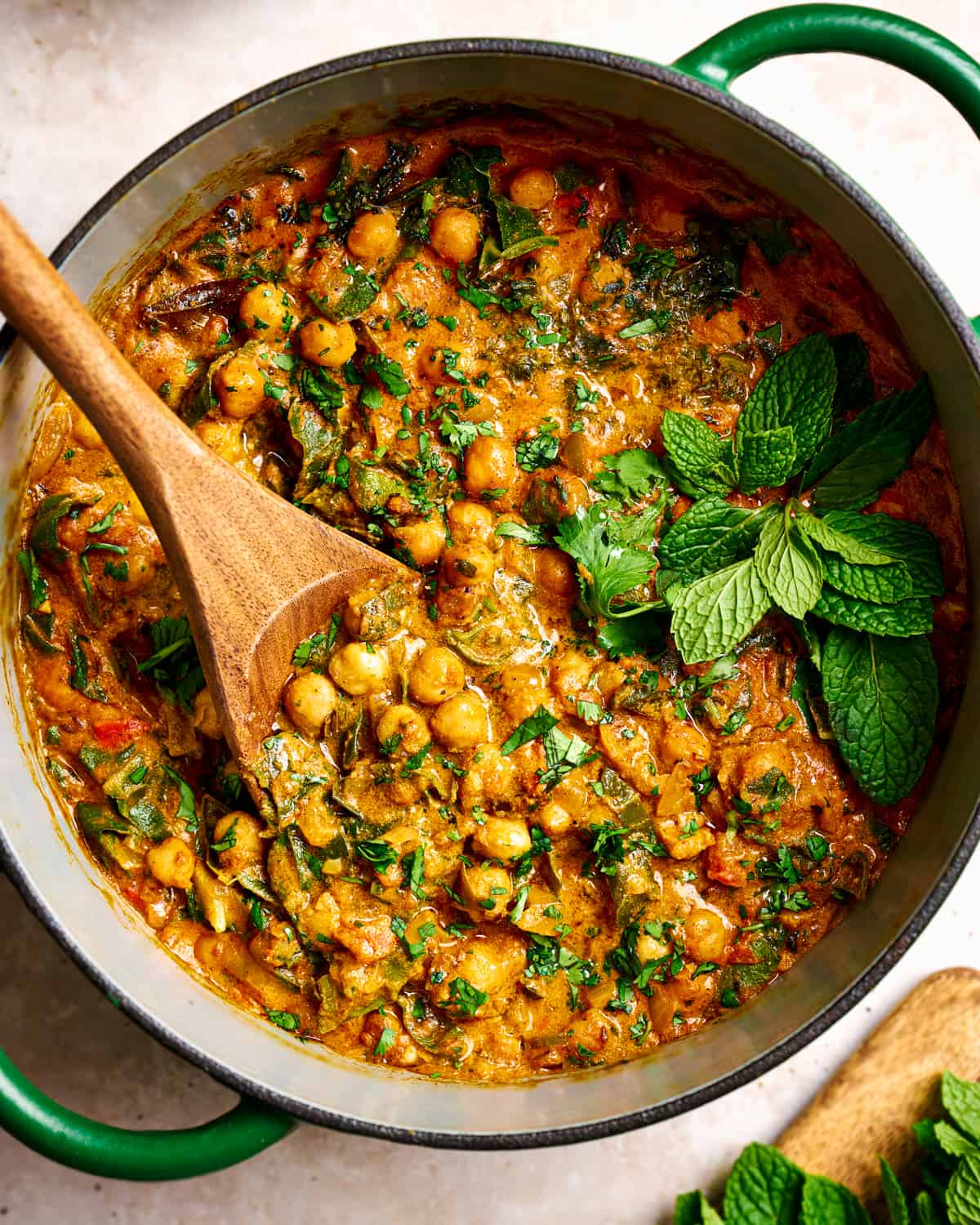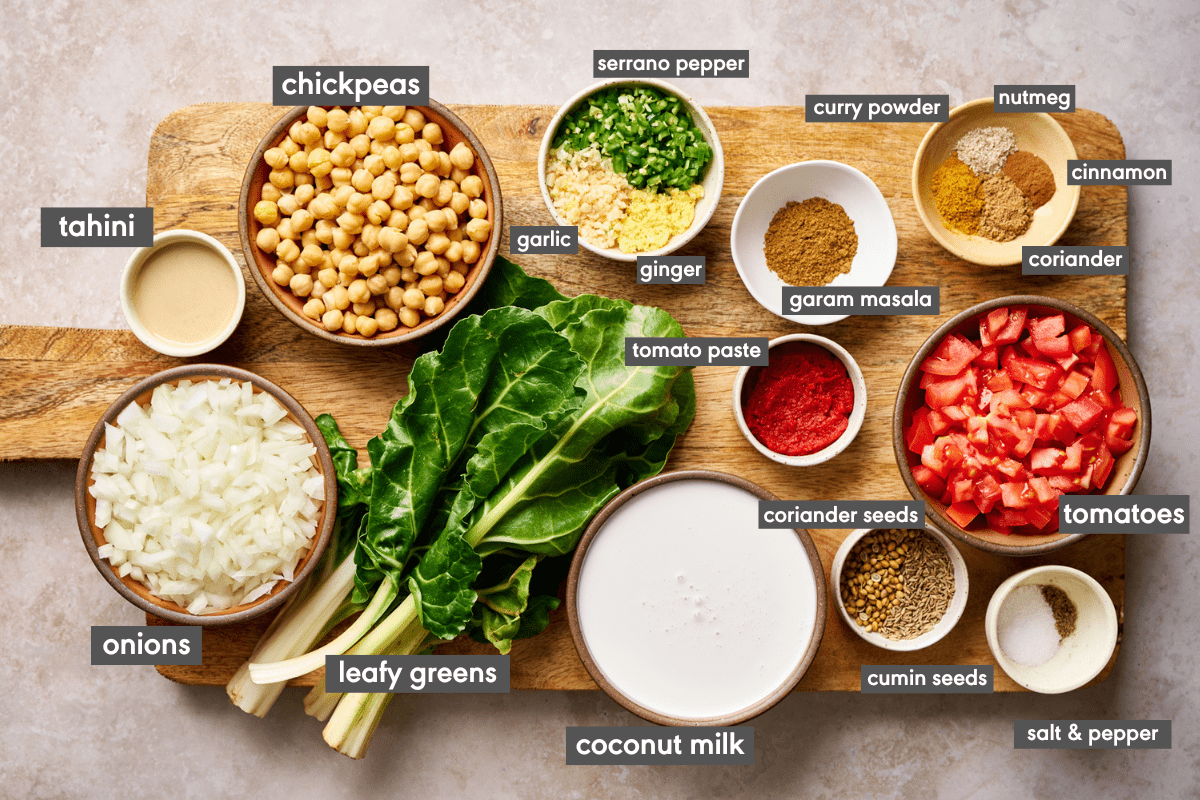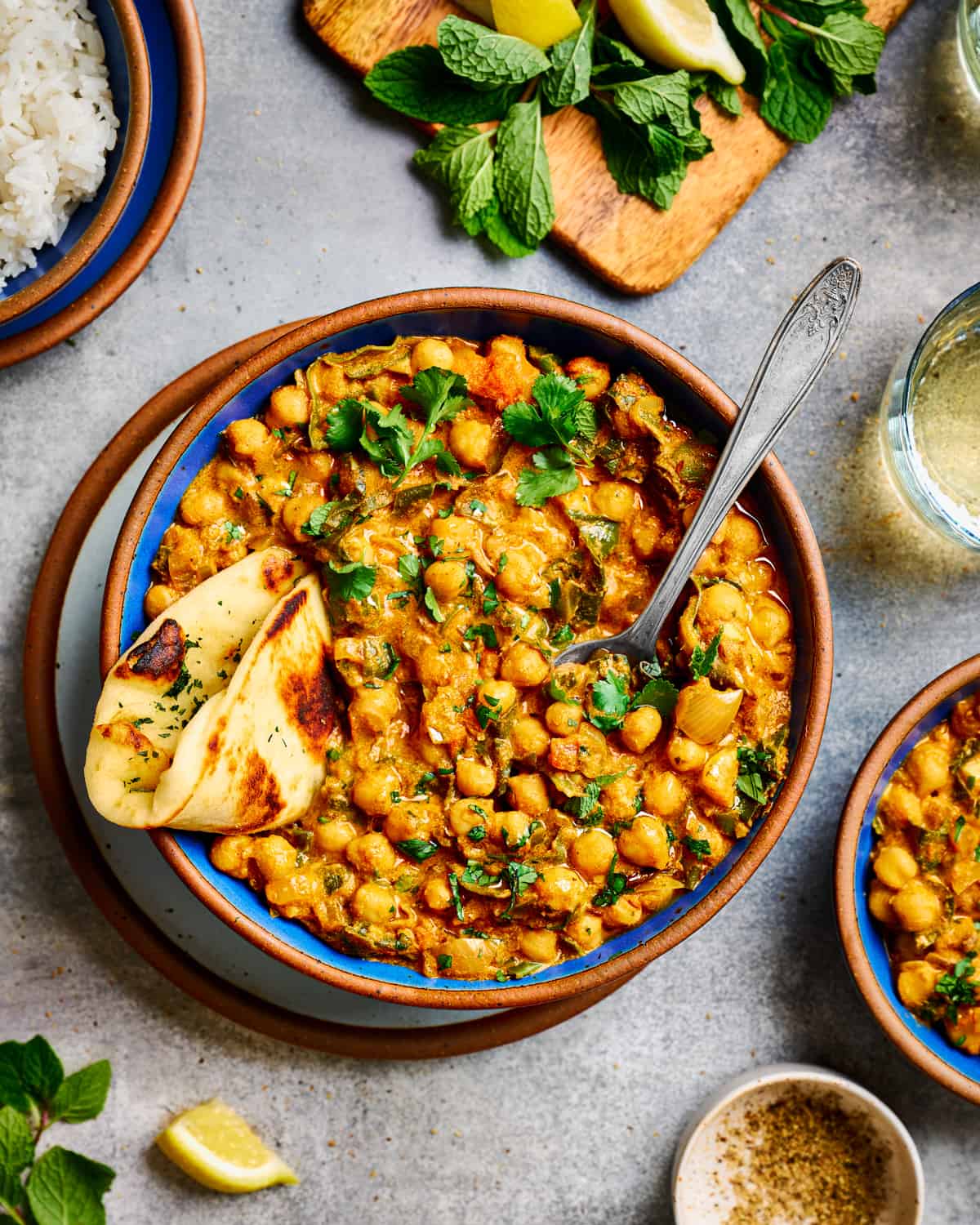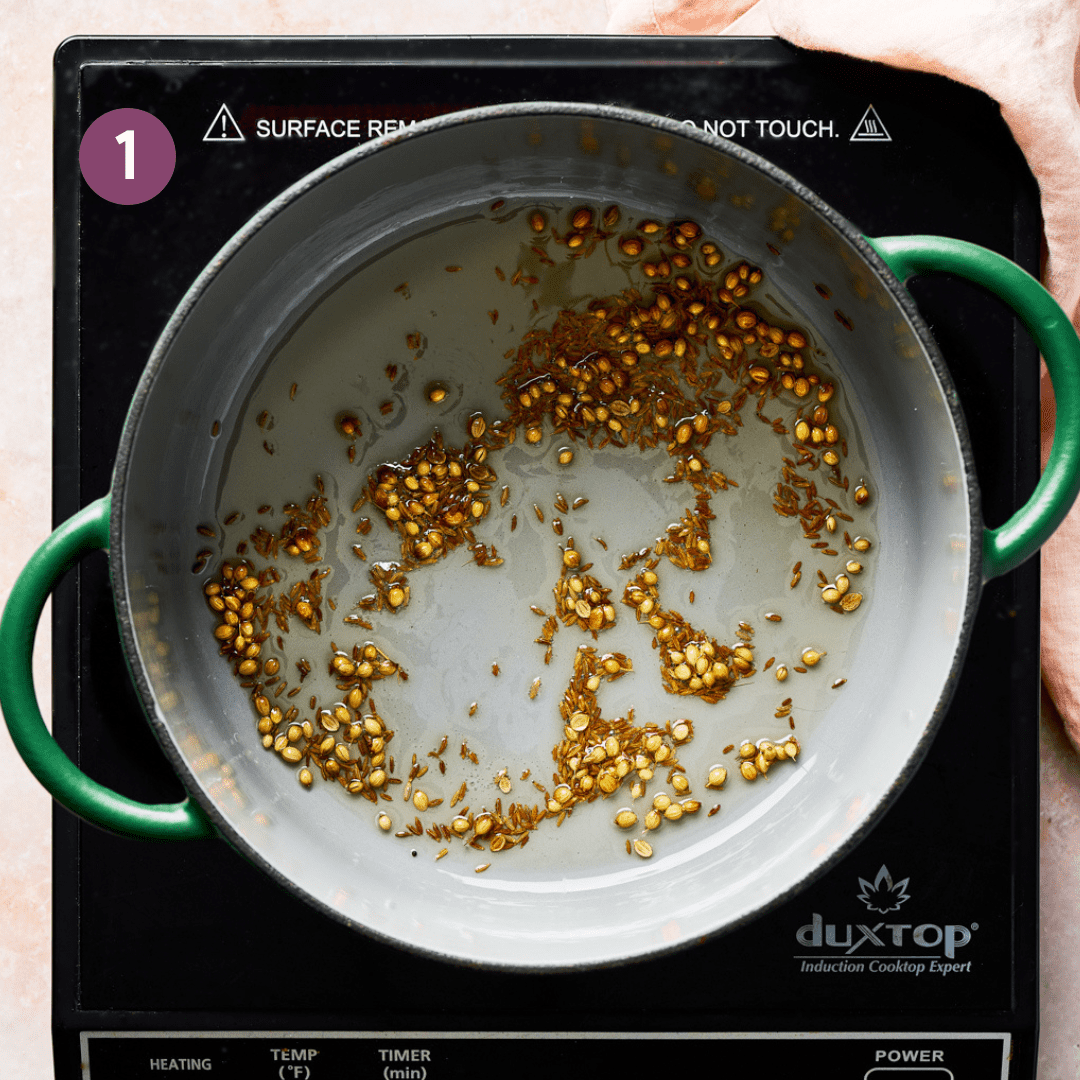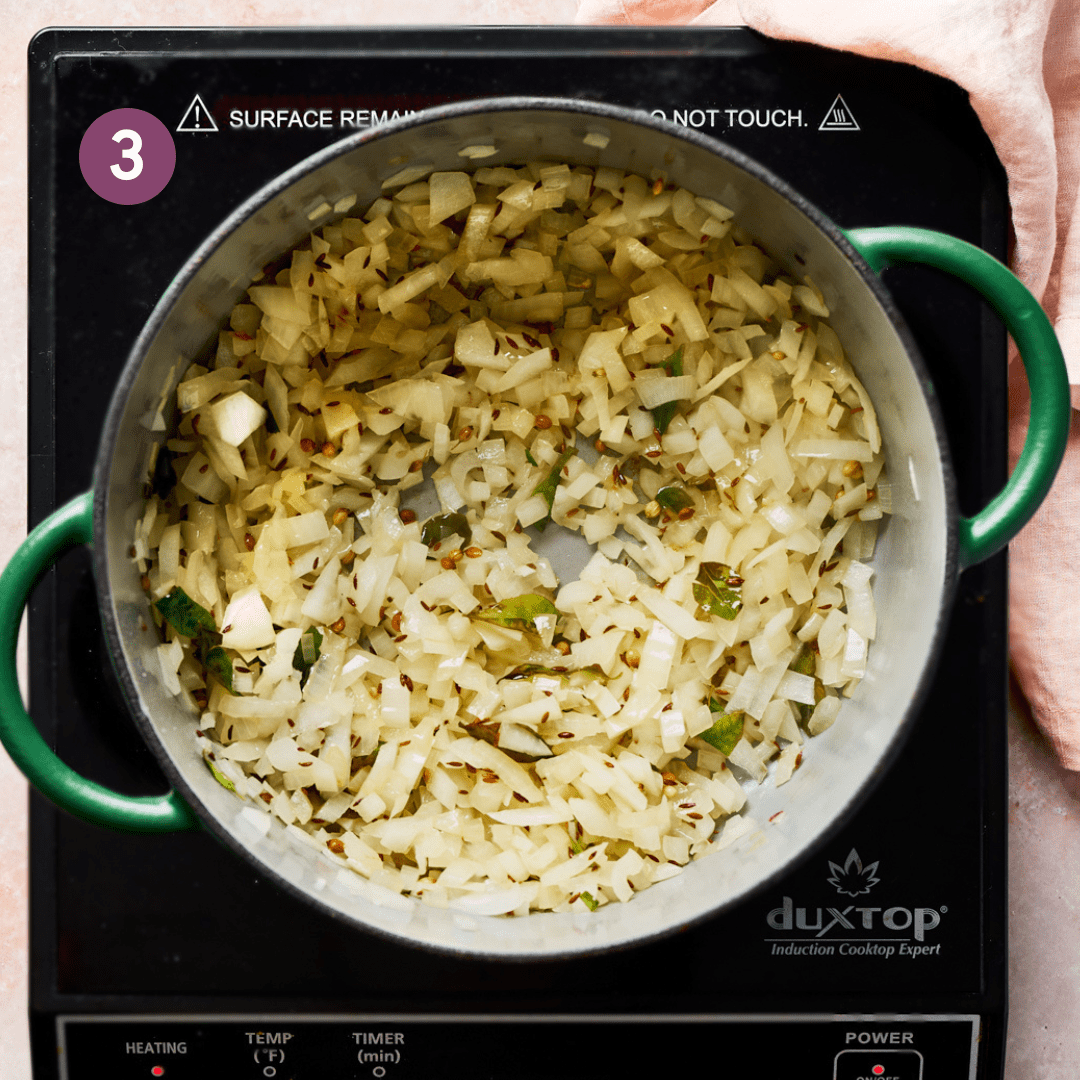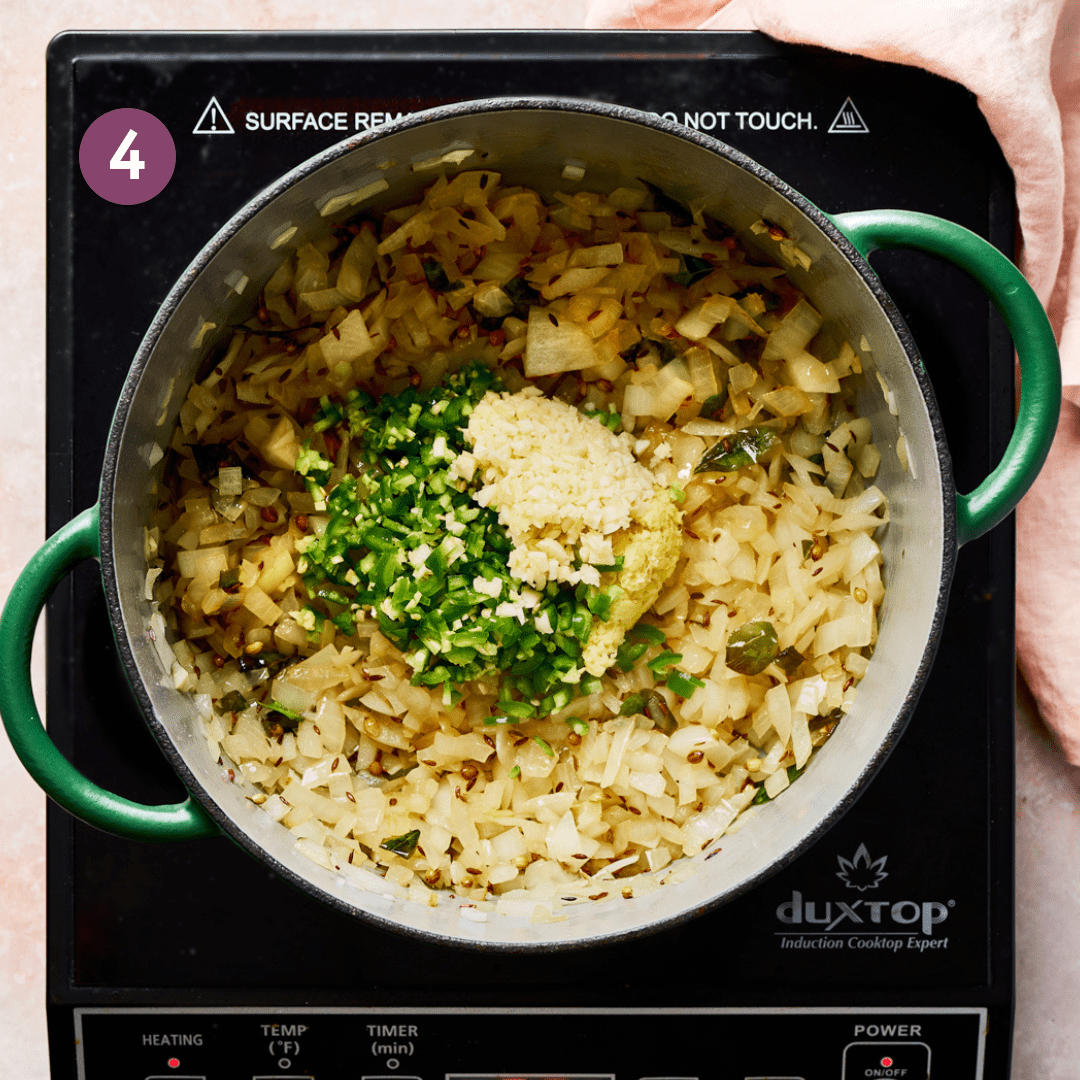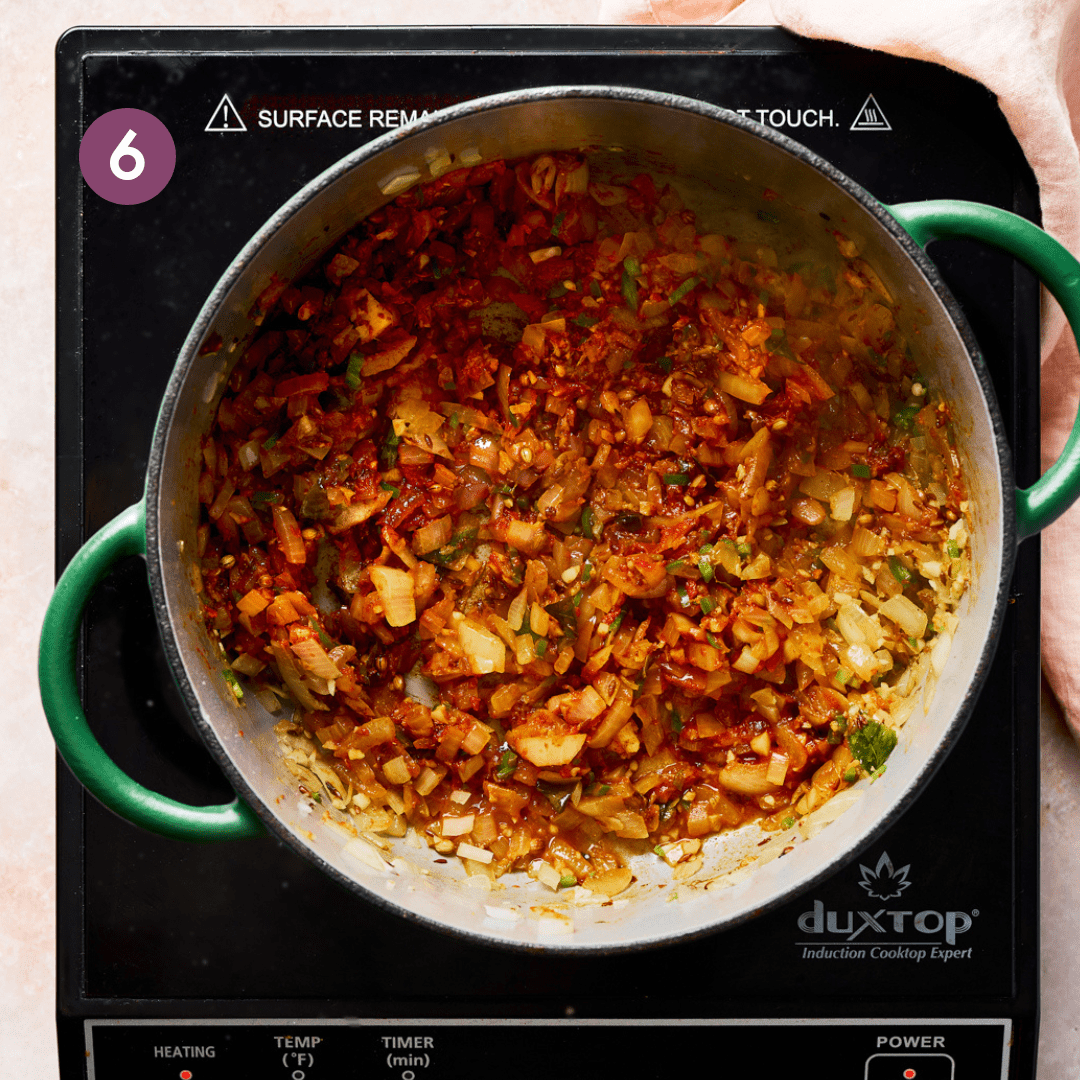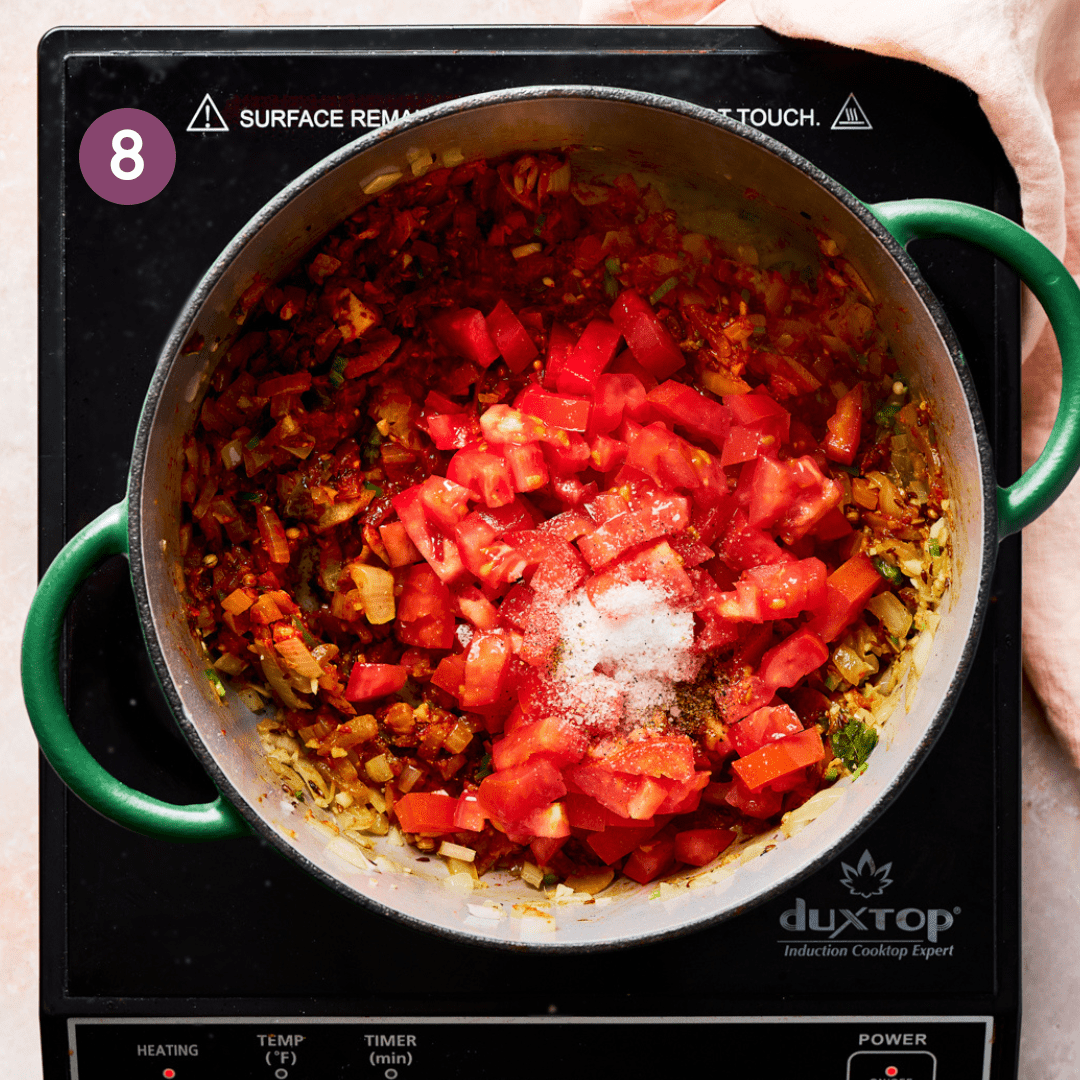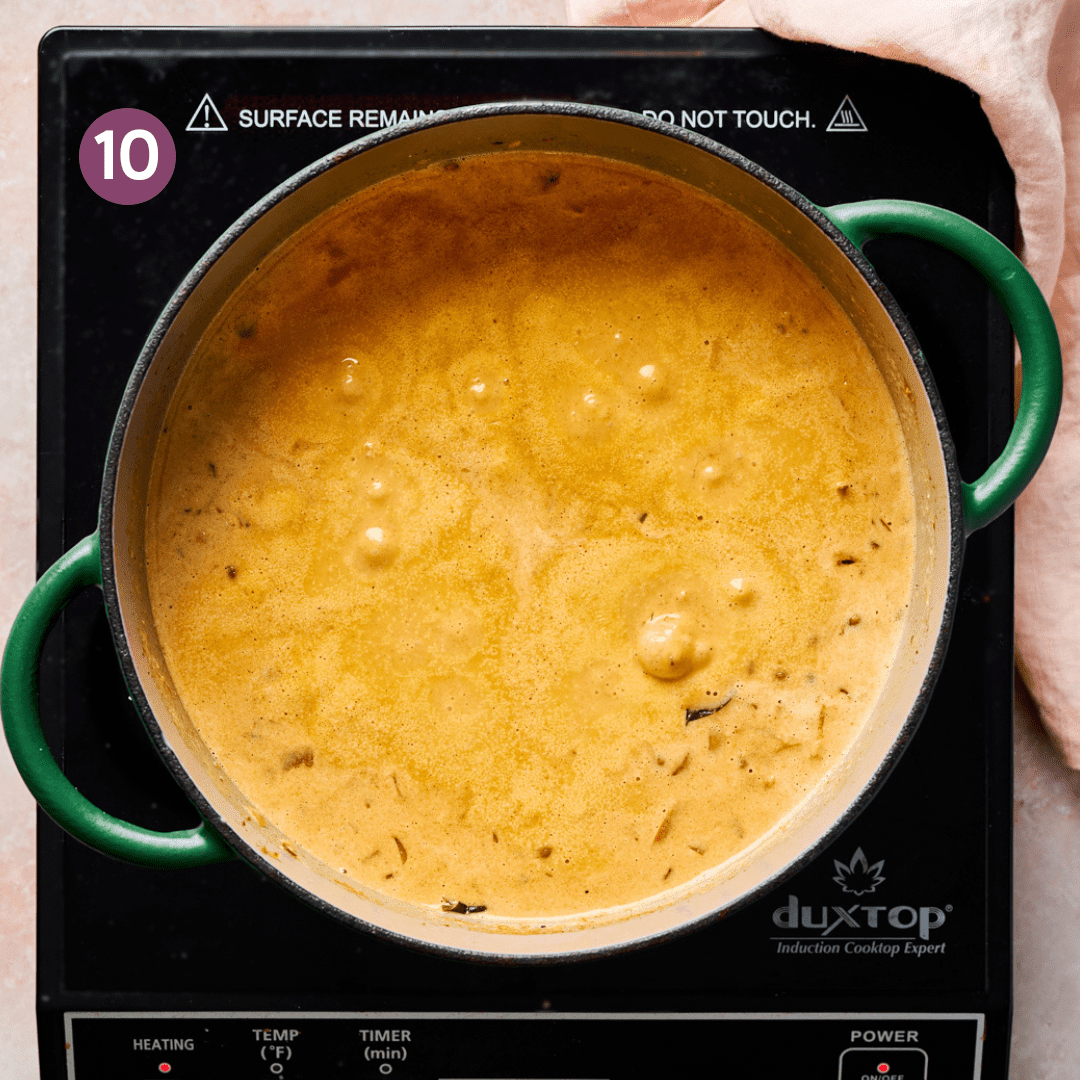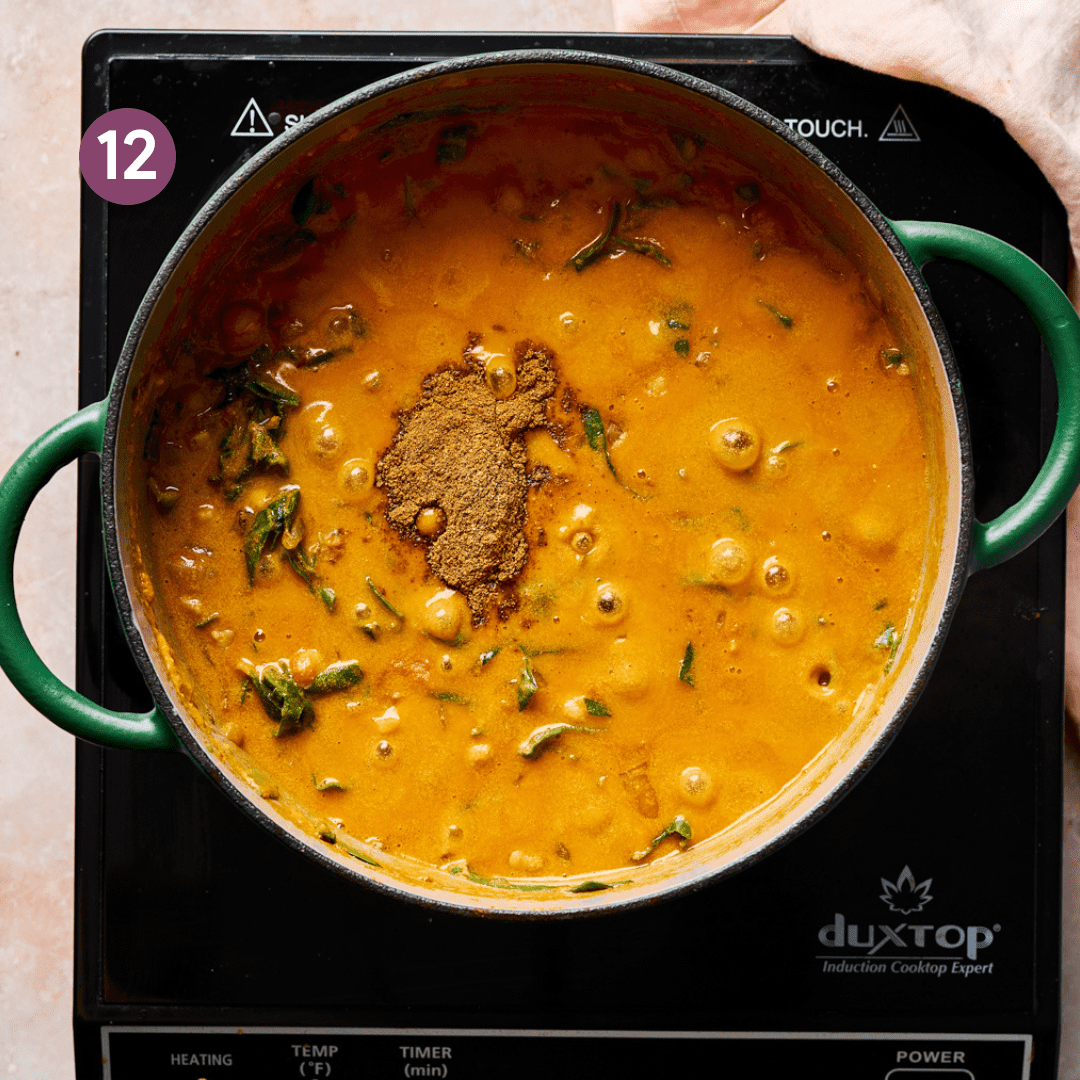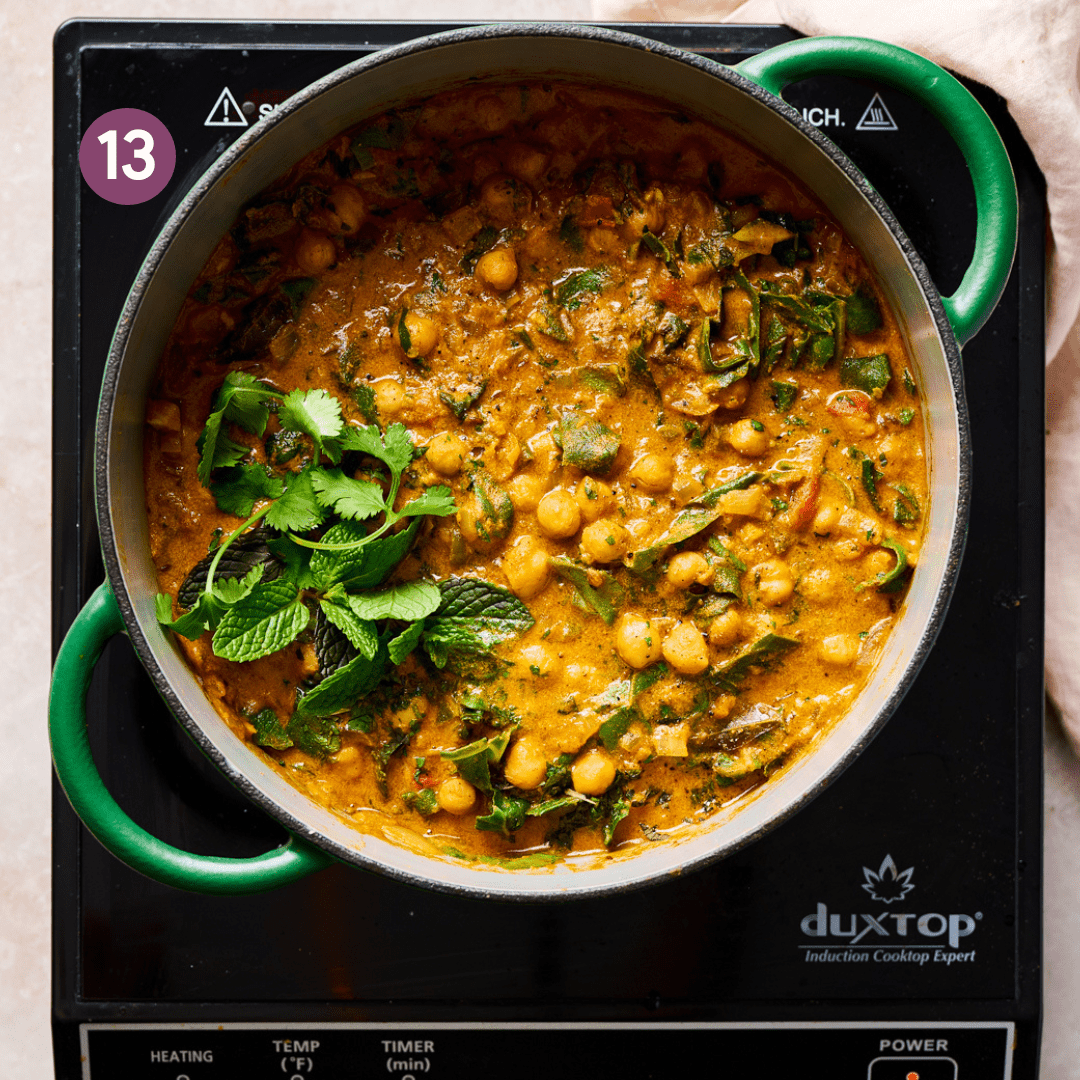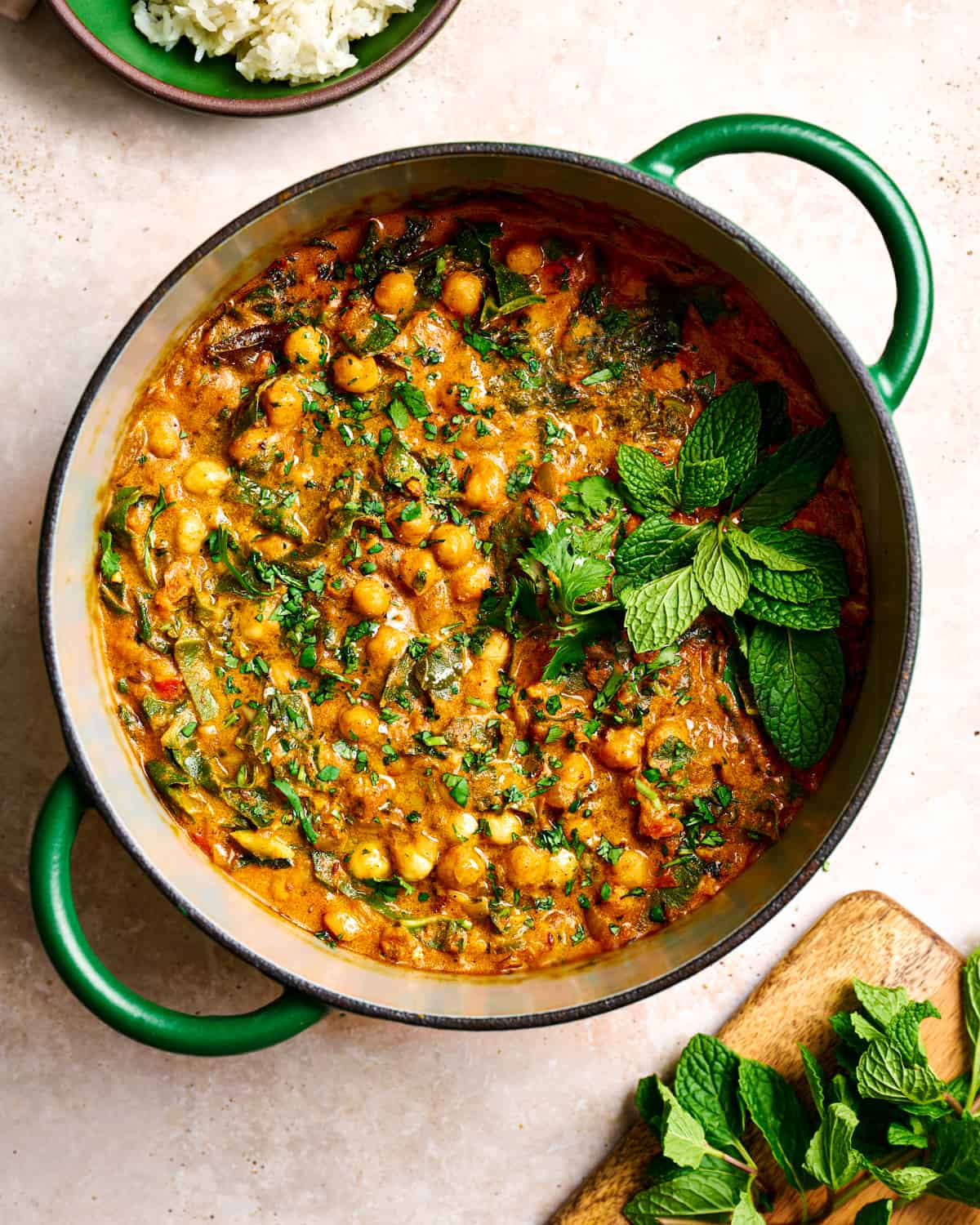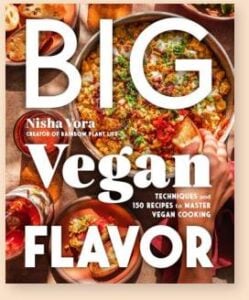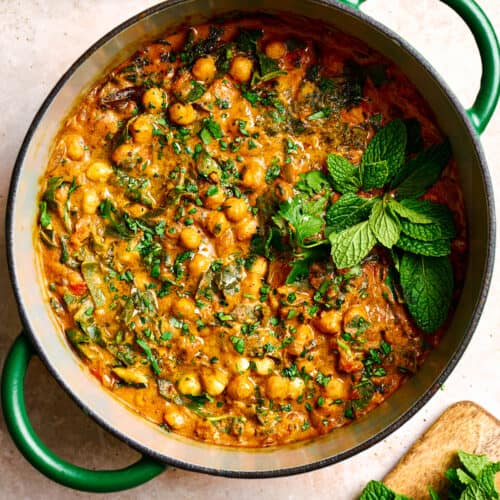It has everything you need in a well-balanced, complete meal. Protein and fiber from chickpeas, fat from the coconut milk and tahini, and even leafy greens! The ultra-rich curry sauce and warm spices will pull you in for bowl after bowl.
Why this recipe works
Dreamy texture.
Just like my Dal Makhani or Malai Kofta recipes, this chickpea curry has a luxuriously creamy consistency with a great mouthfeel. Rich and fatty coconut milk and subtly nutty and creamy tahini turn this into a seriously warm hug in a bowl. But there are also tons of nourishing ingredients in this curry, like antioxidant-rich spices; anti-inflammatory garlic, ginger, and chile peppers; nutritional superstar dark leafy greens; and protein-packed chickpeas.
Loads of warmly spiced Indian flavor.
While not a traditional Indian dish, this chana masala-inspired chickpea curry will remind you of an Indian restaurant-style gravy. Similar to my Vegan Tofu Curry, you get those bold layers of spiced flavor without putting in as much work required of a more authentic recipe. It features a rich and velvety gravy, similar to North Indian dishes, with a few flavors and ingredients from South Indian cooking that I love, like curry leaves and coconut milk. In addition, this recipe fuses warm, earthy warm spices (cumin and turmeric) with bright, citrusy spices (coriander and curry leaves). And a blend of whole and ground spices bloomed in oil maximizes the complex, yet nuanced flavors. Top every serving with cool, refreshing mint leaves and you have a vegan curry that will make your taste buds dance! PS: If you are looking for a more traditional Indian dish, try the Chana Masala in my cookbook, The Vegan Instant Pot Cookbook!
The complete big batch meal.
This meal has protein, fiber, fat, and even greens. Plus, you’ll have plenty of leftovers (the flavor gets better the next day!). Enjoy leftover chickpea curry throughout the week, as a grab-and-go lunch, and for pre-prepared dinners. As explained in the Tips section, you can prep the vegetables and aromatics during your weekly meal prep to make cooking this dish even quicker. Plus, this curry freezes well so you can store it in the freezer during your busiest weeks.
Ingredient notes
Chickpeas. Because it just wouldn’t be a chickpea curry without the chickpeas! Plain ol’ canned chickpeas will do just fine and add over 20 grams of plant protein to the batch. Of course, if you cook your beans from scratch, this curry will be even better. Want to cook the beans yourself but don’t know how? Follow my guide to learn How to Cook Beans in the Instant Pot. This a quick and easy alternative to the stovetop method with NO soaking needed. The Indian Holy Quaternity. AKA onions, ginger, garlic, and green chiles (serrano or jalapenos). So many Indian dishes start with the “holy quaternity”, as I discuss in the video for my Red Lentil Curry because they provide such a flavorful baseline. Whole spices. I urge you to join “Team Whole Spices” for this chickpea curry recipe because they far outshine pre-ground spices. Blooming (or toasting) the spices in an oiled pan is the secret to revealing their hidden flavors. Once toasted, whole cumin and coriander seeds plus curry leaves are more vibrant and bold in flavor, adding layers of earthy warmth and bright citrus to each bite. Substitute: If you only have pre-ground spices at home: use 1 ½ tsp ground coriander instead of 2 tsp whole coriander seeds; use a heaping ½ tsp ground cumin instead of 1 heaping tsp of whole cumin seeds. Where to buy: Well-stocked grocery stores sell cumin and coriander seeds; they’re always available at Indian grocers. If you have an Indian grocer near you, seek out fresh curry leaves: they add an incredible citrusy yet pungent flavor. Alternatively, you can order dried curry leaves online (affiliate link). Ground spices. One of the reasons Indian food is so dang good is that it layers both whole and ground spices for complex layers of flavor. Here, I use a simple mix of curry powder, coriander, turmeric, cinnamon, and freshly grated nutmeg, plus garam masala as a finishing spice. Tomatoes. Diced Roma tomatoes and tomato paste form a team that provide this Indian curry with its necessary tang. Substitute: Use half of a 14-ounce can of diced tomatoes if you don’t want to chop them yourself. Coconut milk. Canned coconut milk brings the richness you’d expect from a restaurant-style Indian curry and tempers the heat from the chiles. Always use coconut milk from a can, not the refrigerated coconut milk in a carton. Tahini. You’ll always find tahini (ground sesame paste) in homemade hummus, but an Indian curry? Not so much. But, this Middle Eastern staple brings a nutty indulgence to all kinds of recipes, like my Tofu Scramble. Here, it adds a subtle decadence and lovely mouthfeel without adding a distinct flavor, similar to what almond butter does in my fan favorite Red Lentil Curry. Fresh herbs. Cilantro and mint are most commonly used in Indian cooking. They offer balance and brightness among the rich and creamy bites. Mint, in particular, brings a lovely cooling accent to the warm spices.
Step-by-step instructions
Toast the whole spices. Heat the oil in a skillet over medium-high heat, then add the cumin and coriander seeds. Toss frequently until toasty and darker in color, but don’t burn. Next, add the curry leaves. If using fresh leaves, immediately cover the pan with a lid to prevent the oil from splattering. Sauté the aromatics. Add the onions and cook until they begin to develop some color. Pour in a splash of water to prevent browning, then add the garlic, ginger, and chile peppers for 1 to 2 minutes. Add the ground spices and tomato paste and stir vigorously for about 90 seconds. Add the tomatoes and their juices to the pan. Let the tomatoes simmer for a few minutes or until they start to break down. Next, add the chickpeas, followed by he coconut milk, water, and tahini. Bring the mixture back up to a simmer, then cover the pan. Stir the chopped greens into the curry when it’s done simmering. Add the garam masala when the leaves have wilted. Off of the heat, add the lemon juice, cilantro, and mint. Give it a taste and adjust the flavors as needed. Serve with basmati rice or Homemade Vegan Naan, then enjoy!
Tips for making this recipe
Prep in advance. Get the curry on the table even faster by dicing the onion, dicing the tomatoes, and prepping the aromatics (garlic, ginger, chiles) 1 or 2 days ahead of time. Store them in separate containers in the fridge. In addition, mix the ground spices together and store the mixture in a ziploc bag or jar on your counter. With the prep out of the way, dinner will be ready in 35ish minutes. And always multitask. Rinse and slice the greens while you wait for the chickpea curry to simmer. Once they’re added in, chop the cilantro and mint. And while the onions cook, measure out your ground spices. Take shortcuts if you need to. This is a flexible dinner recipe with a few shortcut options: (1) Buy pre-washed baby spinach or baby kale instead of the Swiss chard or kale. Cook for 1 to 2 minutes until wilted; (2) Use half of a 14-ounce can of diced tomatoes instead of dicing fresh tomatoes by hand. Chop the greens finely. There’s nothing worse than an unusually large, hard-to-manage piece of kale or Swiss chard among an otherwise easy-to-eat curry. To avoid this, slice the greens into very fine pieces. I slice them like I chiffonade basil: roll the leaves up, then slice into thin strips. PS: If your bunch of greens is large, you will need to add more salt, as dark leafy greens absorb a lot of flavor! Customize if you want. While I love this curry as written, if you have an extra veggie you want to sneak in, go ahead! Sauté a diced red bell pepper or finely diced carrots for a few minutes after the onions. For a sweet element, add a peeled and diced (cooked) sweet potato when you add the coconut milk. For more nutrient-dense goodness, add small or medium cauliflower florets when you add the coconut milk. Seek out curry leaves. This recipe is extraordinary with fresh curry leaves, so if you have an Indian grocery store, please seek these out. You can freeze leftover curry leaves for another time. If you don’t have access, try to get some dried curry leaves online (affiliate link). They don’t have as much flavor, but are still delicious. When added to hot oil, fresh curry leaves bubble up rapidly. To prevent oil splattering on you, stand back when you add them and immediately cover the pan. Cook for just 20 seconds, then remove the lid (they will be sizzling less by now) and add your onions. If you love this vegan Chickpea Curry, please be sure to leave a rating and review below! It’s always much appreciated :) And tag me on Instagram – I love hearing your feedback. Recipe: Nisha Vora / Rainbow Plant Life | Photography: Megan Morello
Big Vegan Flavor
Techniques and 150 recipes to master vegan cooking.
